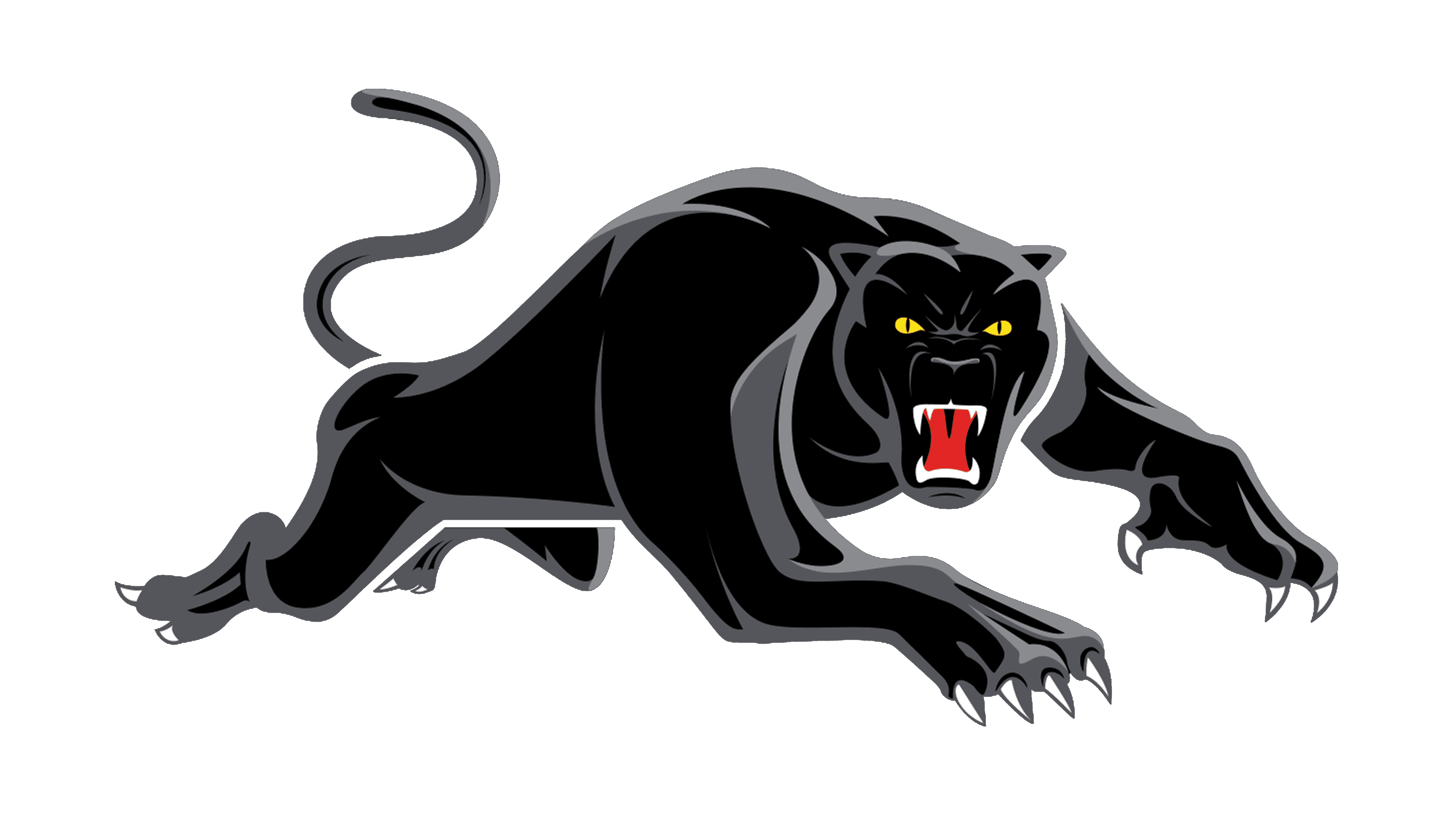Penrith Panthers Logo
The Penrith Panthers, a prominent rugby league club, have established themselves as a dominant force in the sport, particularly in the National Rugby League (NRL) in Australia. In 2023, they continued their remarkable run of success, achieving the rare feat of winning three consecutive NRL premierships, a testament to their consistent excellence and resilience. The team’s remarkable comeback in the grand final, led by standout performances from key players like Nathan Cleary, exemplified their winning mentality and skill. Off the field, the Panthers Group has grown into one of the largest collections of clubs in New South Wales, serving as a major sporting and community hub in western Sydney. The organization actively engages in corporate partnerships, offering a range of hospitality and event opportunities, and enjoys a strong relationship with their passionate fan base and the local community.
Meaning and history
From its inception in 1966 as part of the New South Wales Rugby League, the Penrith Panthers have carved a unique path in rugby league history. Initially, they faced numerous challenges, struggling to find their footing in the highly competitive environment. However, the team’s resilience and strategic planning set the stage for a remarkable evolution.
The 1980s marked a significant era of transformation for the Panthers. This period saw the emergence of key players who would become central to the team’s identity and success. The culmination of these efforts led to their first Grand Final appearance in 1990, a pivotal moment that underscored their rising prominence in the league.
Their crowning achievement came in 1991 with the club’s first NRL premiership, a milestone that reflected the fruits of their labor and dedication. The following years were a mix of triumphs and challenges, showcasing the dynamic and unpredictable nature of professional sports.
The turn of the millennium heralded a new era of success. The Panthers’ 2003 NRL premiership win underscored their resurgence and focus on nurturing young talent, a strategy that has become a defining feature of the club. This approach to team building has been instrumental in their recent successes.
The Panthers’ recent history is marked by extraordinary achievements, notably their three consecutive NRL premierships from 2021 to 2023. This era has been defined by standout performances from players like Nathan Cleary, illustrating the club’s excellence in developing top-tier talent.
Off the field, the Panthers’ impact extends beyond the rugby pitch. The Panthers Group has evolved into a significant entity, representing one of the largest club collections in New South Wales. Their role as a community and sporting hub in western Sydney is complemented by active engagement in corporate partnerships and community initiatives.
The story of the Penrith Panthers is not just one of athletic prowess; it is a narrative of growth, community engagement, and enduring spirit. From their humble beginnings to their current status as NRL champions, the Panthers have become synonymous with resilience, strategic innovation, and a deep connection with their supporters.
What is Penrith Panthers?
The Penrith Panthers are an iconic Australian rugby league team, known for their compelling performances in the National Rugby League (NRL). Established in 1966, they have grown from a modest beginning to become a symbol of sporting excellence and community spirit, particularly in Western Sydney. The team’s history is marked by resilience and strategic evolution, culminating in multiple NRL premiership victories.
1967 – 1977
The emblem features a silhouette of a leaping panther, captured in mid-pounce against a background halved in navy and white. The letter “P” stands prominently in red, anchoring the word “Penrith” above and “Panthers” below, both enveloped within the embrace of a circular border. This logo encapsulates the team’s dynamism and agility, symbolizing their competitive spirit and quick strike capabilities on the field. The color scheme of red, navy, and white adds a layer of visual impact, with the red exuding energy and passion, the navy conveying a sense of professionalism and power, and the white offering a clean contrast that brings balance to the design.
1978
This logo features a more detailed and ferocious depiction of the panther in full leap. The animal’s muscular form and outstretched claws suggest motion and aggression, embodying the team’s fierce competitiveness. The circular border has transitioned to a more subdued brown, with the team’s name, “Penrith Panthers,” inscribed in a bold, sans-serif font that encircles the panther. This design signals a shift from the earlier minimalist style to a more intricate and vivid representation. The updated imagery indicates evolution and perhaps a more modern approach to the team’s branding strategy, reflecting a renewed vigor and presence within the league. The color choices and the panther’s dynamic posture in this iteration are crafted to leave a lasting impression of the team’s identity and spirit.
1979 – 1990
The logo retains the leaping panther motif, now rendered in a striking blue shade, symbolizing vigor and vitality. Encircled by a brown and white ring, “Penrith” arches above while “Panthers” anchors below, both in an assertive, no-nonsense typeface. Compared to the previous iteration, the panther’s form has been refined for a more streamlined effect, and the color palette is simplified, favoring a bold blue that stands out and captures the viewer’s attention. This evolution in design reflects a modernization of the team’s image, aiming for a crisp, contemporary look while maintaining the essence of the club’s identity. The circular boundary unifies the elements, reinforcing the team’s cohesive and determined nature.
1991 – 1999
The logo showcases a significant design evolution, featuring a panther in mid-roar with a stark black and white contrast, emphasizing a powerful and assertive presence. The inclusion of a rainbow spectrum adds a striking visual element, symbolizing diversity and vibrancy, which contrasts with the previous logo’s more uniform color scheme. The panther is now more detailed, with each muscle outlined to suggest strength and movement, while the circular band containing the team name “Penrith Panthers” remains, now framed by the colorful rings. This iteration conveys a modern and inclusive image, reflecting a bold step forward in the team’s branding, suggesting a commitment to both heritage and progression.
2000 – 2013
The logo presents a dramatic shift, focusing on a head-on portrayal of the panther, set against a bold geometric background. The ferocity of the panther is captured in the detailed artwork of its face and open jaws, signaling a team that’s fiercely competitive and ready to face any challenge. The word “PENRITH” sits above and “PANTHERS” below, both encased in a stylized, angular font that adds a contemporary edge. The departure from the full-body panther to just the head allows for a more focused and intense representation of the team’s mascot. The color palette remains within the traditional range but includes a teal accent, providing a fresh and modern twist. This updated emblem symbolizes a new era for the team, reflecting a more aggressive and assertive identity.
2014 – 2018
The logo evolves to a sleeker, more dynamic form, depicting a prowling panther in a poised and predatory stance. The creature is stylized with fluid lines and a teal outline, enhancing its motion and predatory essence. This contrasts with the previous logo’s face-forward, static representation. The word “PANTHERS” below is bold and assertive, with sharp edges that echo the agility and fierceness of the mascot above. The new design signifies a shift towards a more streamlined and modern aesthetic, aligning with contemporary branding trends and highlighting the panther’s inherent power and grace. The overall effect is one of a team that’s both strategic and swift, a formidable competitor in the league.
2019 – Today
The logo portrays a panther in mid-pounce, with a sleek, black silhouette against a white background, exuding a sense of motion and ferocity. The panther’s eyes are highlighted in yellow, piercing through the design and directly engaging the viewer, while its open mouth and sharp teeth convey a strong sense of aggression. This design marks a departure from previous iterations by focusing on a more stylized and graphic representation, rather than a detailed illustration. The absence of additional text or a containing shape suggests confidence, allowing the panther itself to fully embody the team’s spirit and identity. The streamlined design reflects a modern approach to branding, prioritizing clean lines and impactful visual elements to capture the team’s essence.















